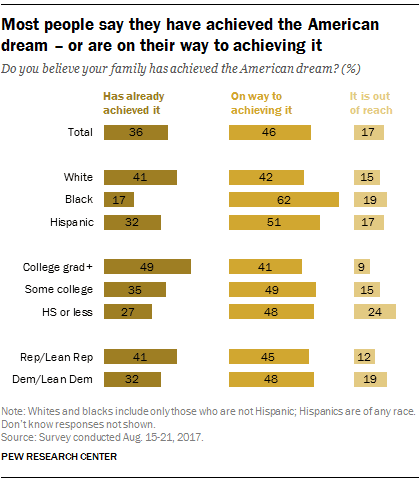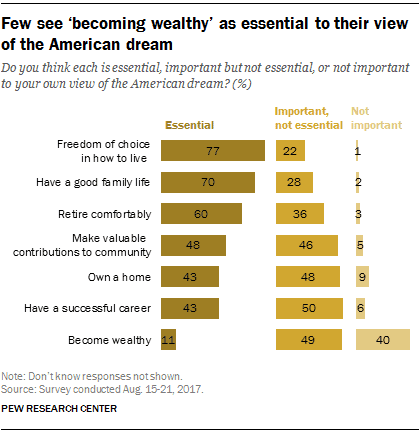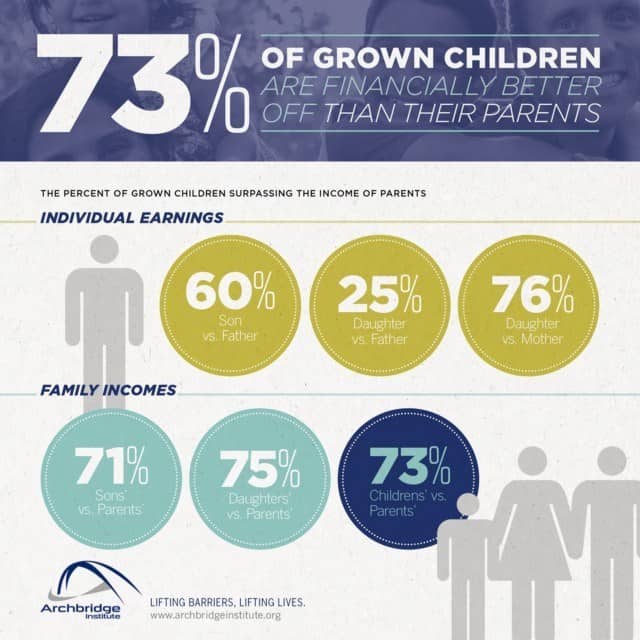This article was originally published in Medium.
Growing up abroad, the American Dream always fascinated me. As a would-be American immigrant, my dream was to join the ranks of many other immigrants from around the world who built this country and made the American Dream their own. When I finally immigrated to the United States nine years ago, I began the search for my own American Dream, I just hadn’t realized it yet.
My wife and I immigrated to the U.S. for similar reasons, looking for opportunities provided by the institutions and culture of entrepreneurship found here, yet are lacking in the Latin American countries we left behind. We agree that the best gift we have given our children is having and raising them here, in one of the only countries where we can honestly tell them, “You can be anything you want.”
My son Sebastian is currently obsessed with dinosaurs and, at age six, already thinks he wants to be a paleontologist. He might change his mind as he grows older, but if he doesn’t, there are more paleontology programs and careers in the U.S. that he can pursue than I can count. In my native Uruguay and in Bolivia, where my wife and I lived before emigrating, opportunities in the paleontology field are few.
My career began when I decided to study economics to pursue my own passion — eradicating poverty. However, I never thought I would end up starting a think tank in pursuit of that goal. I completed my undergraduate studies in Bolivia, where the job options for economists are limited to working at an “independent” (read: government-run) think tank, at a multilateral organization, for the central bank, or as an adjunct professor. Non-governmental organizations are rare, as are economist positions at private firms.
So after immigrating to the United States, completing a graduate degree in economics, and working for years in the nonprofit sector, I’m currently pursuing my own American Dream by studying one of its key pillars — economic mobility.
Achieving big dreams doesn’t come easily, but what characterizes the American Dream is that anything is possible through hard work and perseverance. I don’t know what the future holds, but just having the opportunity to pursue this career path and my own happiness is so extraordinary.
It is this gift that my wife and I have given our children — the greatest gift we could ever give — yet it seems some Americans are taking it for granted.
Too many misunderstand what the American Dream is or undervalue its importance. The American Dream does not guarantee a safe or secure road to success. What it offers is the opportunity to chart your own path. This is what matters, and many Americans have lost sight of just how rare and incredible it is.
By examining some of the latest polling, research, and commentary, I try to answer the question: Is the American Dream still alive and well in the U.S. of A.?
DEFINING THE AMERICAN DREAM
The American Dream has meant many things to different people throughout history. There are dozens of definitions, but the one first coined by James Truslow Adams in his 1931 book The Epic of America continues to be one of the best: The American Dream “is that dream of a land in which life should be better and richer and fuller for every man and woman, with opportunity for each according to his ability or achievement.”
One of the most pressing questions of our time is whether this dream is still alive, if it’s fading, nonexistent, or if it’s simply out of reach for most Americans. While a definitive answer has been elusive, policymakers, scholars, and analysts should consider the available evidence.
One way to approach answering this question is by polling and gauging the public’s opinion on the matter. The Pew Research Center conducted a poll last year asking people what they thought about the American Dream.
The majority of Americans from all groups say they have achieved their American Dream or are on their way to achieving it. Only 17 percent said the American Dream is out of reach. This can and should be better, but it is still somewhat encouraging. Lately, it seems many politicians, public intellectuals, and media personalities would have us think that the American Dream is dead.

In The Epic of America, James Truslow Adams adds, “[The American Dream] is not a dream of motor cars and high wages,” and according to Pew’s recent poll, Americans agree. Only 11 percent of respondents believed wealth to be an essential part of their American Dream.
The largest number of respondents, 77 percent, said freedom of choice in how to live is essential to their view of the American Dream. The significance of this cultural attitude shouldn’t be underestimated or understated in what makes the American Dream.

Economic mobility is an essential environmental condition necessary for the American Dream to thrive. In order for individuals to pursue their goals, people will move up and down the income ladder as they take chances and make adjustments. What we want to see is high rates of upward absolute economic mobility, indicating that individuals have the freedom to take the risks needed to achieve their American Dreams — regardless of income level — and that those risks resulted in increased income.
Analyzing recent research on economic mobility might help us to understand why so many leaders have become concerned about the health of the American Dream. Economist Raj Chetty and his team at the Equality of Opportunity project released an exhaustive report on the topic in December 2016 titled “The Fading American Dream.” They found that absolute economic mobility, defined as how many children earn more than their parents did at the same age (usually between their 30s and 40s), has declined dramatically in recent decades. According to their research, of the cohort of children born in the 1940s, 90 percent surpassed their parents’ income; whereas, only 50 percent of the cohort born in the 1980s surpassed the income of their parents.
At the Archbridge Institute, we decided to examine the evidence ourselves. Dr. Scott Winship, Archbridge honorary advisor, found that the figure for the cohort born in the 1980s is closer to 68 percent. Winship explains in his study, Economic Mobility in America, that after adjusting for family size and using an improved measurement for inflation, the economic mobility outlook isn’t quite so dismal. When using a different data set, the Panel Study of Income Dynamics, Dr. Winship shows that the figure may actually be 73 percent. Though this is shy of the 90 percent rate of upward mobility enjoyed by the 1940s cohort, it still means that almost three quarters of Americans are better off than their parents — it’s not perfect, but it’s not terrible either.

When examining the bottom of the income distribution, according to the Pew Research Center, 93 percent of kids born in the poorest quintile earn more than their parents did at the same age. And if we take into account improved technology and higher living standards, progress has been even better than the data suggests.
FACTORS INFLUENCING ECONOMIC MOBILITY
Scholars and analysts have yet to reach a consensus on what barriers exist that stand in the way of increased upward economic mobility. Some of these barriers are likely the same barriers that limit freedom of choice, an essential part of most people’s American Dreams.
There are many other factors and indicators worthy to explore as researchers assess possible barriers to upward economic mobility. One such indicator might be the decline in business dynamism in the United States, signaling that fewer people are starting businesses and taking risks to pursue their Dreams. A harder-to-measure but surely significant factor is the decline in social capital, which results from many other mobility-influencing issues such as family structure and involvement in one’s community (which is essential to achieving the Dream for 48 percent of Americans). There is also reason to believe that a lack of soft skills is preventing individuals from gaining fruitful employment.
Other barriers to economic mobility are related to culture. The entrepreneurial spirit is part of America’s backbone, but it seems to be waning in recent years. That spirit has always driven Americans to work hard and persevere. Unfortunately, popular culture today often vilifies hard work and success. Celebrities, public figures, and even some scholars suggest that for someone to have improved their life, they must have done something detrimental to another’s life. Working under the idea that life is a zero-sum game leads many in the public eye to become extremely concerned about inequality.
As I’ve written previously, there has been extensive research into the role of culture, rhetoric, and institutions in economic development. Scholars Joel Mokyr and Deirdre McCloskey contend that what preceded the great industrial revolution and gave way to our modern economy were institutional and cultural changes that affected how we viewed entrepreneurship, innovation, and value creation. Entrepreneurship, trade, and the commercial society have been around for thousands of years across the globe. The essence of what changed is our perception of how noble, virtuous, or dignified we thought it was to engage in those vocations.
There is a need for people, and especially entrepreneurs themselves, to recognize the positive impact that their work has on society as a whole and, most importantly, to empower others to pursue their own dreams. As American society has begun to rail against inequality, frowning upon entrepreneurs gaining wealth — even as a stepping stone to achieving their Dreams — and labeling them exploiters of the working class, it is no longer sufficient to generate jobs and create successful businesses, entrepreneurs must also survive the court of public opinion by virtue signaling their support for various causes including reducing income inequality.
Scholars and policymakers concerned about inequality focus on relative economic mobility, instead of absolute economic mobility. Rather than comparing an individual’s income to their parents’ income at the same age, relative mobility compares an individuals’ income quintile to their parents’ income quintile at the same age. Measurements of relative mobility assume a zero-sum game: Even if everyone in a generation out-earned their parents, relative mobility could still be quite low if children ended up in the same income quintile as their parents.
Unfortunately, many policies intended to reduce income inequality by increasing upward relative mobility for the poorest quintile — like raising the minimum wage and mandating employers offer paid leave benefits — often hurt the individuals they were trying to help and erect further barriers to economic mobility, entrepreneurship, and the American Dream.
THE HEALTH OF THE AMERICAN DREAM
Not quite as many Americans are moving up the income ladder in their lifetimes as there were decades ago, but the American Dream is still thriving. With absolute economic mobility ranging from 50 to 73 percent, depending on the method of calculation, work remains to remove the barriers that are keeping Americans from having the freedom of choice in how to live that will allow them to take the risks necessary to achieve their American Dreams, and hopefully move up the income ladder in the process.
Our culture of entrepreneurship is fading, and without it we will lose one of the main means by which people achieve their American Dreams: hard work and perseverance. As politicians and celebrities look to blame inequality for poverty, they vilify the “fat cat” entrepreneurs they believe are exploiting workers — not providing them with hard-earned paychecks. With that mindset, hard work is no longer praised, upward economic mobility slows, and the American Dream inches out of reach for more and more people.
Partisan and divisive times have not been the exception but the norm throughout the history of the United States. During these times, the most important, binding idea that has brought and should continue to bring people together is the American Dream. Especially in its original definition of a land seeking to provide better, richer, and fuller lives for all of its citizens. Now more than ever, it is essential that Americans unite under the ethos of the American Dream to bridge our current divides. We must continue to value hard work and entrepreneurship — and also freedom, family, and community — to ensure that the American Dream flourishes for the next generation.


